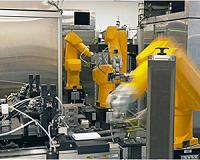| . |  |
. |
London UK (SPX) Dec 20, 2010 our flawed understanding of how decisions in the present restrict our options in the future means that we may underestimate the risk associated with investment decisions, according to new research by Dr ole Peters from Imperial College London. The research, published in the journal Quantitative Finance, suggests how policy makers might reshape financial risk controls to reduce market instability and the risk of market collapse. Investors know that there are myriad possibilities for how a financial market might develop. Before making an investment, they try to capture these possibilities in a single number to represent likely market performance. They can do this in one of two ways: 'ensemble averaging,' which runs possible scenarios in parallel, or 'time averaging,' which runs scenarios in sequence. The ensemble average is the most commonly used approach. It is based on imagining multiple scenarios that all begin from the same starting conditions, and then averaging their outcomes. The alternative, time averaging, imagines all possible scenarios playing out over time. As we live on a timeline, previous decisions cannot be undone as time passes. Any new decision constrains our choices when making subsequent ones. Time averaging provides the more accurate prediction for the real world outcome of an investment decision. The study shows that, in the investment world, the differences in the results from these two approaches are critical: time averaging inherently incorporates a measure of risk, but ensemble averaging does not. This means that ensemble averaging consistently undervalues risk by underestimating the effects of time on investments and overestimating the degree of choice that investors have. It also encourages excessive leveraging of investments, which itself accentuates fluctuations in the market, increases market volatility, and imparts a negative drift in the market that helps drive investors into negative equity. "In the investment world, ensemble and time averages give different results, with ensemble averages systemically ignoring the effects of fluctuations," said Dr ole Peters, author of the study from the Department of Mathematics and Grantham Institute for Climate Change at Imperial College London. "If investors routinely used time averages, it would help to avoid scenarios such as the excessive leveraging of investments that contributes to market instability and the likelihood of market collapse." The recent financial crisis clearly shows the effects of excessive leveraging used both between banks, and between banks and their borrowers. Investors using time averaging to calculate risk would require a good reason to exceed a leverage factor of 1. Leverage factors of 40-60, as used by some banks before the crisis, would ring alarm bells. Thus, time averaging could provide policy makers and regulators with an indication of the kind of ratios that we should expect in a healthy, robust investment market. "Too often, investors behave as if they had access to different scenarios playing out in parallel universes whose outcomes they combine and average," explained Dr Peters. "This misleadingly encourages them to think they have more choice and face less risk than is actually the case. In reality, we are stuck in one universe and, as a consequence, time has a bigger effect on investment risk than we imagine." "Finding more accurate ways to predict and manage risk will improve the way we prepare for and respond to extreme events, and will help our consideration of future risks due to a changing climate," said Professor Sir Brian Hoskins, Director of the Grantham Institute for Climate Change at Imperial College London. "In the wake of the financial crisis we are all aware of the fragility of the investment markets. This new research helps us understand why excessive risk-taking happens, how it destabilises the markets, and how regulators might better monitor and manage markets in the future".
Share This Article With Planet Earth
Related Links Imperial College London All About Human Beings and How We Got To Be Here
 Researchers Discover Compound With Potent Effects On Biological Clock
Researchers Discover Compound With Potent Effects On Biological ClockSan Diego CA (SPX) Dec 17, 2010 Using an automated screening technique developed by pharmaceutical companies to find new drugs, a team of researchers from UC San Diego and three other research institutions has discovered a molecule with the most potent effects ever seen on the biological clock. Dubbed by the scientists "longdaysin," for its ability to dramatically slow down the biological clock, the new compound and the ... read more |
|
| The content herein, unless otherwise known to be public domain, are Copyright 1995-2010 - SpaceDaily. AFP and UPI Wire Stories are copyright Agence France-Presse and United Press International. ESA Portal Reports are copyright European Space Agency. All NASA sourced material is public domain. Additional copyrights may apply in whole or part to other bona fide parties. Advertising does not imply endorsement,agreement or approval of any opinions, statements or information provided by SpaceDaily on any Web page published or hosted by SpaceDaily. Privacy Statement |